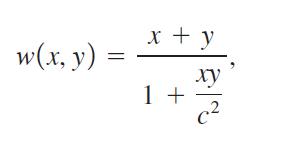In 1931, Albert Einstein developed the following formula for the sum of two velocities, x and y:
Question:
In 1931, Albert Einstein developed the following formula for the sum of two velocities, x and y:
where x and y are in miles per second and c represents the speed of light, 186,282 miles per second.
(a) Suppose that, relative to a stationary observer, a new super space shuttle is capable of traveling at 50,000 miles per second and that, while traveling at this speed, it launches a rocket that travels at 150,000 miles per second. How fast is the rocket traveling relative to the stationary observer?
(b) What is the instantaneous rate of change of w with respect to the speed of the space shuttle, x, when the space shuttle is traveling at 50,000 miles per second and the rocket is traveling at 150,000 miles per second?
(c) Hypothetically, if a person is driving at the speed of light, c, and she turns on the headlights, what is the velocity of the light coming from the headlights relative to a stationary observer?
Step by Step Answer:






